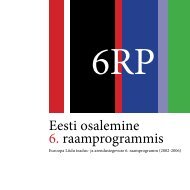Reactive Systems: Modelling, Specification and Verification - Cs.ioc.ee
Reactive Systems: Modelling, Specification and Verification - Cs.ioc.ee
Reactive Systems: Modelling, Specification and Verification - Cs.ioc.ee
Create successful ePaper yourself
Turn your PDF publications into a flip-book with our unique Google optimized e-Paper software.
98 CHAPTER 4. THEORY OF FIXED POINTS<br />
We calculate the sequence F i (Proc × Proc) for i ≥ 1 thus:<br />
F 1 (Proc × Proc) = {(Q1, Q4), (Q4, Q1), (Q2, Q3), (Q3, Q2)} ∪ I<br />
F 2 (Proc × Proc) = {(Q2, Q3), (Q3, Q2)} ∪ I <strong>and</strong> finally<br />
F 3 (Proc × Proc) = F 2 (Proc × Proc) .<br />
Therefore, the only distinct processes that are related by the largest strong bisimulation<br />
over this labelled transition system are Q2 <strong>and</strong> Q3, <strong>and</strong> ind<strong>ee</strong>d Q2 ∼ Q3.<br />
<br />
Exercise 4.11 Using the iterative algorithm described above, compute the largest<br />
strong bisimulation over the labelled transition system described by the following<br />
defining equations in CCS:<br />
P1 = a.P2<br />
P2 = a.P1<br />
P3 = a.P2 + a.P4<br />
P4 = a.P3 + a.P5<br />
P5 = 0 .<br />
You may find it useful to draw the labelled transition system associated with the<br />
above CCS definition first. <br />
Exercise 4.12 Use the iterative algorithm described above to compute the largest<br />
bisimulation over the labelled transition system in Example 3.7. <br />
Exercise 4.13 What is the worst case complexity of the algorithm outlined above<br />
when run on a labelled transition system consisting of n states <strong>and</strong> m transitions?<br />
Express your answer using O-notation, <strong>and</strong> compare it with the complexity of the<br />
algorithm due to Page <strong>and</strong> Tarjan mentioned in Section 3.6. <br />
Exercise 4.14 Let (Proc, Act, { α → | α ∈ Act}) be a labelled transition system.<br />
For each i ≥ 0, define the relation ∼i over Proc as follows:<br />
• s1 ∼0 s2 holds always;<br />
• s1 ∼i+1 s2 holds iff for each action α:<br />
- if s1 α → s ′ 1 , then there is a transition s2 α → s ′ 2 such that s′ 1 ∼i s ′ 2 ;<br />
- if s2 α → s ′ 2 , then there is a transition s1 α → s ′ 1 such that s′ 1 ∼i s ′ 2 .
















